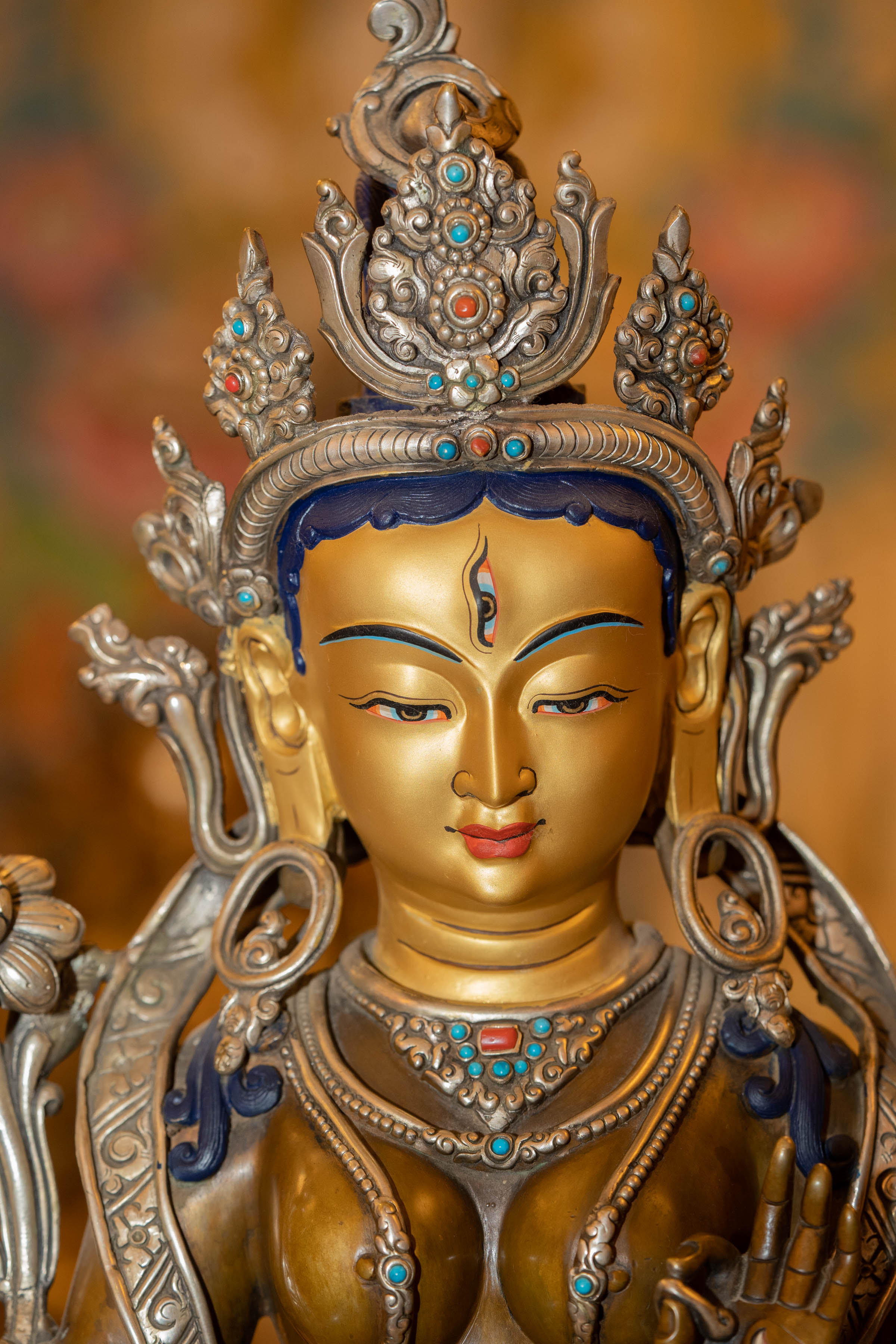In the Tibetan language, “Thang” means “unfolding” or “displaying” and thangka means silk, satin, or cloth painting scroll.
It is a religious form of art that depicts lord Buddha, stories from his life, and his teachings. Usually, thangkas use natural minerals like lapis, lazuli, and painting one is time-consuming because of its devotional nature.
Thangka is a mark of devotion in Buddhism and often serves as an object of worship.
They are common in monasteries, lama residences, family halls for worshiping Buddha, and homes of Tibetan Buddhists. You can hang thangkas in the office or home at your altar basically places that are respectful.
ORIGIN OF THANGKA
In ancient times, the Tibetan monks used to travel around a lot. So, it wasn’t convenient for them to bring along Buddha statues in their journey. That’s when Thangkas were originated. Thangkas can be easily carried around by rolling them up, so, they are portable. Thangkas have a real engagement with art as a religious practice.
Thangka paintings date back to the 11th century A.D. when Buddhists and Hindus in Asia began to make illustrations of the deities and natural scenes. These thangkas serve as important teaching tools depicting the life of Buddha, various influential lamas, other deities, and bodhisattvas.
The art of thangka is entirely based on the spirituality of Buddhism. The main source of Tibetan art that has flourished for centuries is the iconographical art of India, its strong influence is from China.
Traditionally, thangka paintings are not only valued for their aesthetic beauty but primarily for their use as aids in meditational practices.
SIGNIFICANCE OF THANGKA

Understanding Buddhist philosophy and symbolism is the key element in creating a Thangka. The artist has to have a visualization of the image in advance. It also depends on how much complexity and details you want.
It invokes the blessings of the Buddha and is meditative. The meditative component of thangka has to be upheld. The very reason we have tradition is to maintain them but it is important to be inventive at the same time to make this art more useful and help it continue.
Thangkas are usually placed upright in a rectangular shape while there are a few that deal with subjects of mandala that are square. Cotton and linen are common fabrics on which pictures are painted with mineral and organic pigments while silk is reserved for important subjects.
Buddha and his principles are about enlightenment. There are two ways for enlightenment; they are Samatha meditation and Vipassana. Samatha means mindfulness meditation and vipassana means insight meditation.
SIGNIFICANCE OF SAMATHA MEDITATION
So, Samatha is regarded as contemplative technology, it entails no belief system, no commitment to any ideology or institution or any group. It is simply a way of refining the mind in very specific ways that make a mind serviceable, flexible, supple, malleable, and useful for all types of activities.
The physical ramifications of the practice of Samatha:
As long as we are alive, our minds are embodied minds, they’re profoundly entangled with, interrelated with not only the brain but the entire nervous system, the entire body, and the body is related with the environment. And so if we’re going to be training the mind: cultivating, refining the mind, there must be correlated shifts in the body in terms of one’s nervous system. So as the mind becomes more supple, more light, more buoyant, and also filled with a greater sense of well-being, you will discover that the body is also shifting: stress starts to decrease, a sense of malleability, pliability, pliancy, suppleness, buoyancy arises with this practice.
WAY TO HEAVEN THANGKA PAINTING
There are various types of thangka paintings, the way to heaven Thangka painting depicts Samatha meditation.
Samatha is a Sanskrit term, it means quiescence, tranquility, serenity, calm, calm presence, or peaceful presence but that’s just the etymology. What Samatha is referring to us here in thangka and meditational practices are methods that are designed to develop your attention and metacognitive skill.
You can maintain continuity of attention and vividness of attention. So, in order to develop our attention skills through the methods of Samatha, you must be also honing your metacognitive or introspective skills. So, you can recognize when your mind is becoming distracted or dull.
You’ve got to learn how to stay focused in any type of contemplative practice. Buddhism is exceptionally rich in this regard.
Symbolism in Way to Heaven Thangka
- The Path or the Way - The path to awaken or The Way to Nirvana
- The Monkey - Mental Agitation or Emotional Disturbances
- The Elephant - Consciousness
- The Stick - Alertness to control the Elephant
- The Rabbit - Changing the mind or Disturbances
- The Rope with Monk - Mindfulness
🙉 Monkey: The monkey is often depicted in Thangka paintings as a symbol of restlessness, distraction, and the untamed mind. It represents the uncontrolled and undisciplined aspects of our thoughts and emotions that hinder spiritual progress. The monkey serves as a reminder to practitioners to tame and discipline their minds through mindfulness and meditation.
🐘 Elephant: The elephant, on the other hand, symbolizes strength, wisdom, and steadiness. It represents the qualities of stability, power, and mental fortitude that are necessary on the spiritual path. The elephant embodies qualities such as mindfulness, concentration, and the ability to overcome obstacles.
🚸 Road: The road or path depicted in the Thangka represents the spiritual journey towards enlightenment. It represents the steps and stages that practitioners must traverse to attain liberation. The road signifies the commitment and perseverance required to follow the teachings of Buddhism and progress on the path of self-transformation.
🐇 Rabbit: The rabbit is often associated with the moon in Buddhist symbolism. It represents gentleness, tranquility, and humility. The rabbit's presence may symbolize the need for cultivating these qualities on the path to enlightenment. It reminds practitioners to approach their spiritual practice with a calm and humble mind.
🧘♂️ Monk: The presence of the monk in the Thangka painting represents the practitioner or aspirant who is dedicated to the pursuit of enlightenment. The monk symbolizes the committed spiritual seeker who embodies the values and principles of Buddhism. The monk serves as an inspiration and role model for others on the path, representing the embodiment of wisdom, compassion, and discipline.
It's important to note that interpretations of symbols in Thangka paintings may vary, and specific lineages or traditions may have their own nuanced interpretations. Consulting with experienced teachers or masters within the Tibetan Buddhist tradition can provide a deeper understanding of the symbolism and meaning within a particular Thangka painting.
SIGNIFICANCE OF WAY TO HEAVEN THANGKA

There are nine stages of meditation in Samatha meditation. The diagram in this Thangka shows a symbolic representation of the pathway to heaven.
The nine stages of mind training:
As the mind develops through the practice of meditation, it goes through a series of stages or levels. Buddhist practitioners over the centuries have identified nine stages along the path. In the Tibetan tradition, this process of mental development has been diagrammed symbolically as a series of stages in which a monk gradually tames his mind represented by an elephant with also a monkey and a rabbit. In Japanese tradition, similar series of depictions have been used, it is known as the Ox-herding.
Samatha represents the highest union that occurs in the seat of the consciousness. The first stage shows a picture of a monk who represents the meditator or the yogi and he is following after the elephant which represents the mind to be tamed and trained but the mind is being led around by the monkey which represents discursive emotions, ignorance, lusts and so on. In this first set out that’s said to be called searching for the mind, this is done in formal meditation following the techniques of tranquilization of the mind.
In this pictogram, we see fire: fire represents the publication process. Here, we see the meditator chasing further in the second panel. The mind which again is the element being led by the monkey, the monkey represents discursive thought patterns, habitual tendencies. The yogi is trying to unite with the power of yoga which represents the rope he is holding in his hand. And the white on the head of the monkey and the head of the elephant represents the process of purification that takes place when one applies tranquility and insight meditation.
In this third panel, we see that the mind has been finally caught. This is where the great discovery has taken place. The elephant and the monkey are white under all discursive grime. The mind is actually pristine. So, now the monk has slowed down the mind and the discursive emotions at this stage. The yogi experiences the realization of his bad practices and his erratic mind. This is where many meditation practitioners actually have a very difficult time experiencing the control of habitual energy, lusts, and so on.
In this fourth panel, the mind has actually been purified and the monkey is no longer controlling the mind. We have a new subtle aspect that has arrived in the picture and this is the rabbit. The rabbit represents restlessness and quickness of the mind to be unsatisfied with the state of meditation and so on. This erratic nature of mind often leads one into disregarding the practices again because of that restless nature. But this is soon conquered.
In the fifth stage, the meditator has finally taken the lead of the mind and also of the erratic nature of the undisciplined emotions and habits of the monkey and also the rabbit: the dis-satisfied aspect which seeks to stop practice starts developing true meditative absorption.
The mind is able to have absorption into tranquility and insight on its own. The yogi rarely needs to apply any strenuous hook or rope of yoga in order to achieve this. The monkey aspect becomes less interested in leading around the mind. So, it can be said that this is truly a stage where the yogi has achieved the beginnings of mental discipline in a true sense.
The seventh stage represents stillness because the mind and its cravings have finally stopped. The restless monkey mind has abandoned this picture as well as the rabbit. Here, the yogi is absorbed in the genuine Samadhi of tranquility though there is still a memory of mind state. This is where the continued application of stillness of mind is essential.
The meditator at will is leading the mind which has been subdued and eradicated of discursive thought emotions and the poisonous tendencies of the mind. Here, the meditator is living his practice on a day-to-day level at his will. These are known as meditative and post-meditative absorptive practices. Thereby, tranquility is achieved not only while during active meditation but in just ordinary activities as well. This is also seen as loosening up one’s vows to strenuous practice. This is often seen in older age practices of Yogi’s that have been practicing their whole lives. This is where one checks constantly to see if the mind is really truly trained or will revert back to its old untrained nature.
This stage is said to be where the true union of the yogi and his mind. They both can rest together without any fear of returning back to the undisciplined hellish mind state of suffering. Now, the yogi has achieved true Samadhi in his practice. He has been trained, disciplined and now he is experiencing the realization of his genuine effort and practice. This is the ninth stage.
In the tenth picture which isn’t actually one of the stages but this is post-completion. This is said to be the yogi riding his pure mind all the way to home or to Nirvana (heaven).



